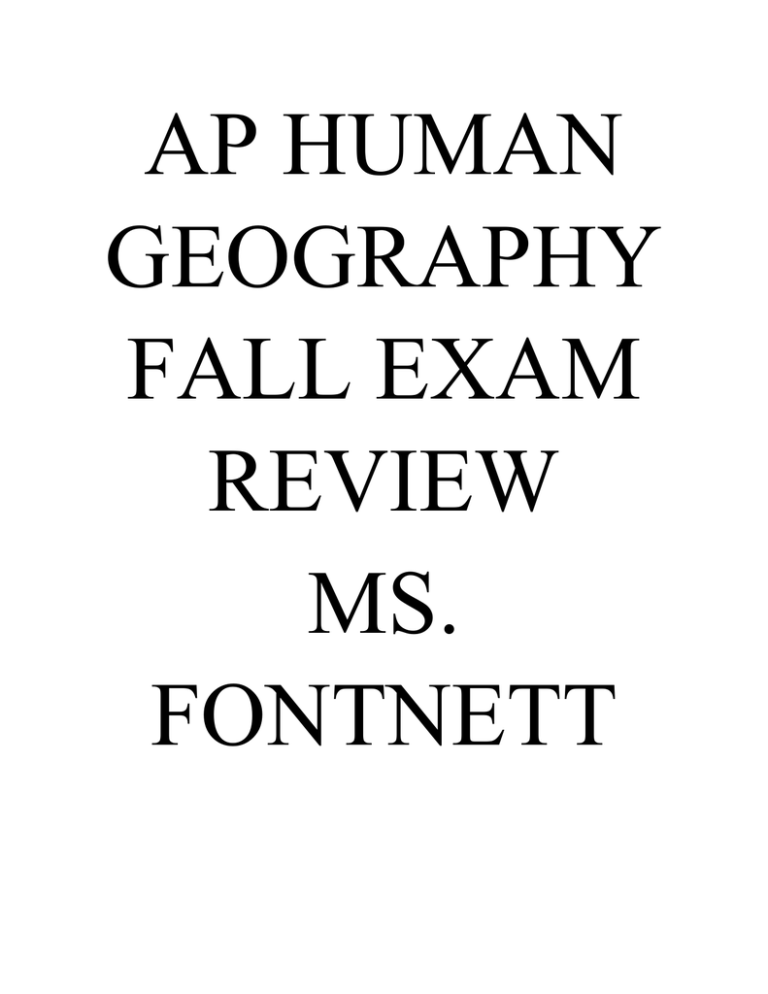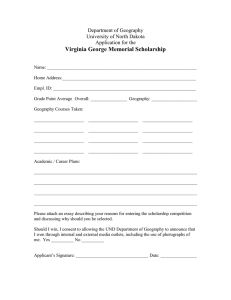Fall Final Exam Review
advertisement

AP HUMAN GEOGRAPHY FALL EXAM REVIEW MS. FONTNETT AP Human Geography Fall Semester Exam Free Response Questions 1. Walls and other barriers built by countries to establish their borders are some of the oldest and most controversial elements in the cultural landscape. a. Identify three examples of walls or other barriers built by countries in the twentieth and twenty first centuries. b. Explain the purpose of one of the examples you identified in part a c. For each of the categories listed below, discuss a consequence faced by countries as a result of walls or other barriers established along their borders. i. social or political ii. Economic iii. Environmental AP Human Geography Fall Semester Exam 2014 This computer system captures, stores, analyzes and displays data. It measures the position of a0n object on earth and stores it in a computer along countless other specific measurements. Each type of information may be stored in a layer and then layers may be combined to present the overall image. 1. The statement above refers to which of the following? 2. The computer system identified in #1 would most likely be helpful in solving problems related to 3. A special type of map designed to reveal the nature of local geography is call a 4. Physiological population density is viewed as a superior measure of population density for which of the following reasons? 5. Which of the following regions has little dairying in its traditional agriculture? 6. The spread of specialty coffee shops across the United States in the 1990s is an example of 7. All of the following statements about the geography of meat production in the United States and Canada are true EXCEPT 8. A formal region defines an area in which 9. Squatter settlements exist in cities of less-developed countries because 10. It is generally agreed that the current trend in climate change is caused by 11. A set of computer tools used to capture, transform, analyze, and display geographic data. 12. Pertaining to the unique facts or characteristics of a particular place 13. Individual maps of specific features that are overlaid on oneanother in a Geographical Information System to understand and analyze a spatial relationship. 14. Systematic approach to physical geography that looks at the interaction between the earth's physical systems and processes on a global scale 15. The realm of geography that studies the structures, processes, distributions, and change through time of the natural phenomena of the earth's surface. 16. Nations based on shared principles, in contrast to ethnic nations, which are based more on cultural commonalities 17. The number of babies who die before age of one per 1,000 deaths. [(number of infants who die before age 1/all births) x 1000] 18. Government attempts to increase or decrease the birth rate in the country 19. The fact that, in the modern world, there is very little "free" migration because of laws and border regulations. Thus, even when people make a free decision to move, they may not be able to migrate 20. Asylum 21. A Moroccan Muslim (1304-1368) who traveled over 75,000 miles and wrote an account of his journeys. 22. A distribution in which data show distinct pockets of concentration 23. Critical geopolitics 24. In Hindu areas, a complex division of society based on hereditary classes that are distinguished by their degree of ritual purity 25. Any attribute that can be considered geographically 26. The permanent relocation of one's place of residence, usually implying a long-distance move 27. Places that are not holy or sacred; everyday places 28. In social theory, social, political, or economic systems that might limit or constrain the human capacity to make more independent decisions; often contrasted with agency 29. The action or movement of people leaving a country to live and permanently settle in a foreign land 30. Human trafficking




